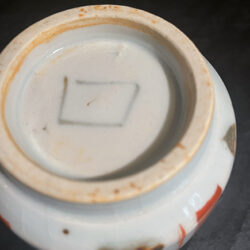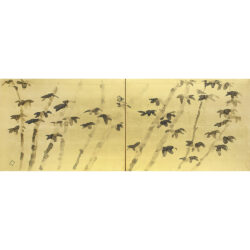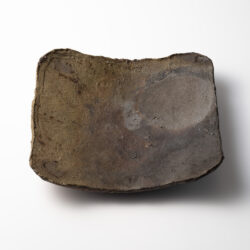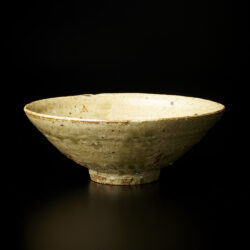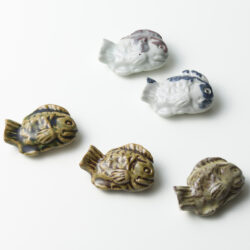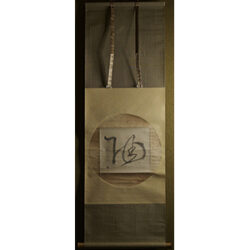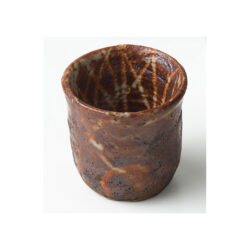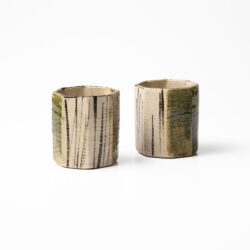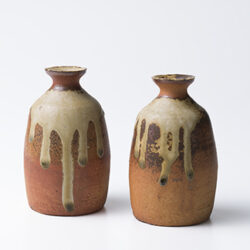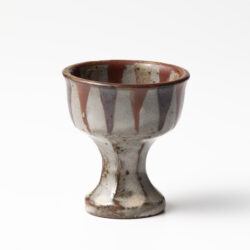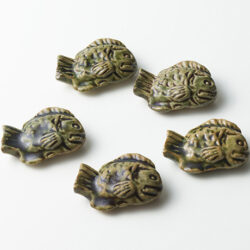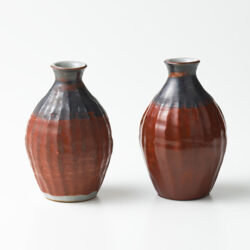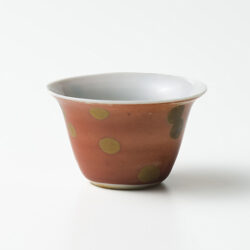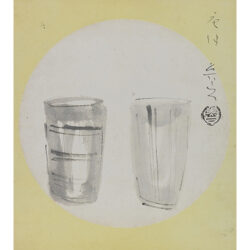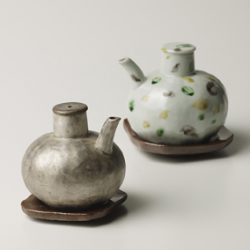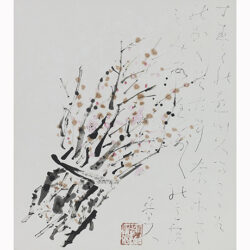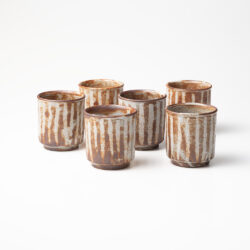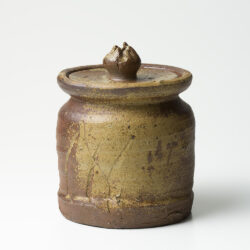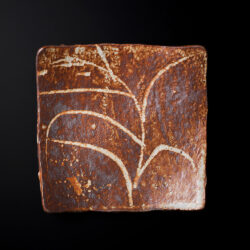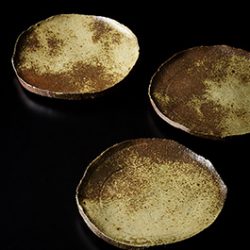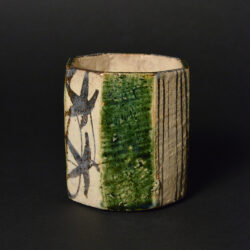色絵有平縞文湯呑 Tea cup, iroe
北大路 魯山人/ KITAOJI ROSANJIN
陶芸で縞模様といえば「間道文」「木賊文」「有平文」などが古くから使われてきた。
とくに桃山時代から織物で多く使われてきた間道文。
利休が唐物茶入の仕服にも使ったことで名物裂として茶人の好みとなっている。
この間道文を好んで作品に取り入れた魯山人先生。
織部や染付、色絵、絵瀬戸などで、子持ち間道も好んだ。
本作品は、赤、青、茶の縞が間隔をあけて配置され、それぞれに、太い線と細い線が並んだ子持ち間道となった縞模様。
「有平縞」(あるへいじま、ありへいじま)とは、安土・桃山時代に伝わった南蛮菓子で砂糖を煮て作られたキャンディーのアルヘイ(アリヘイ)糖が赤、白、青とカラフルな組み合わせだったことから、その配色の縞柄を「有平縞」と呼ぶようになった。
軽快で手に取りやすい作品となっている。
高台内には「ロ」のサインが入る。
In pottery, when we speak of striped patterns, traditional designs such as "Kando-mon," "Tokusa-mon," and "Ariei(Alhei)-mon" have been used since the olden times. Among these, the "Kando-mon," which has been widely used in textiles, originally imported from Southern Asia since the Momoyama period, became particularly favored by tea enthusiasts. It is known among tea masters as a famous fabric pattern used for the Chinese tea caddy that Sen no Rikyu had selected .
Rosanjin himself was fond of the "Kando-mon" pattern and incorporated the "Komochi Kando-mon" (a design featuring narrow lines adjacent to broader ones) into his works, including Oribe ware, sometsuke (blue and white ware), iro-e (multi-colored porcelain), and e-seto (decorated Seto ware).
The present work features a striped pattern known as "Komochi Kendaimon," characterized by alternating red, blue, and brown stripes, with narrow lines running alongside broader ones.
Furthermore, "Ariei" refers to a striped pattern with a colorful combination of red, white, and blue, inspired by the candy "Arihei Sugar" (Alheí Sugar), a type of confectionery made by boiling sugar, which was also introduced to Japan during the Momoyama period by the Nanban traders.
The design of this piece is lighthearted and easy to handle.
The base bears the signature mark “ロ.”
とくに桃山時代から織物で多く使われてきた間道文。
利休が唐物茶入の仕服にも使ったことで名物裂として茶人の好みとなっている。
この間道文を好んで作品に取り入れた魯山人先生。
織部や染付、色絵、絵瀬戸などで、子持ち間道も好んだ。
本作品は、赤、青、茶の縞が間隔をあけて配置され、それぞれに、太い線と細い線が並んだ子持ち間道となった縞模様。
「有平縞」(あるへいじま、ありへいじま)とは、安土・桃山時代に伝わった南蛮菓子で砂糖を煮て作られたキャンディーのアルヘイ(アリヘイ)糖が赤、白、青とカラフルな組み合わせだったことから、その配色の縞柄を「有平縞」と呼ぶようになった。
軽快で手に取りやすい作品となっている。
高台内には「ロ」のサインが入る。
In pottery, when we speak of striped patterns, traditional designs such as "Kando-mon," "Tokusa-mon," and "Ariei(Alhei)-mon" have been used since the olden times. Among these, the "Kando-mon," which has been widely used in textiles, originally imported from Southern Asia since the Momoyama period, became particularly favored by tea enthusiasts. It is known among tea masters as a famous fabric pattern used for the Chinese tea caddy that Sen no Rikyu had selected .
Rosanjin himself was fond of the "Kando-mon" pattern and incorporated the "Komochi Kando-mon" (a design featuring narrow lines adjacent to broader ones) into his works, including Oribe ware, sometsuke (blue and white ware), iro-e (multi-colored porcelain), and e-seto (decorated Seto ware).
The present work features a striped pattern known as "Komochi Kendaimon," characterized by alternating red, blue, and brown stripes, with narrow lines running alongside broader ones.
Furthermore, "Ariei" refers to a striped pattern with a colorful combination of red, white, and blue, inspired by the candy "Arihei Sugar" (Alheí Sugar), a type of confectionery made by boiling sugar, which was also introduced to Japan during the Momoyama period by the Nanban traders.
The design of this piece is lighthearted and easy to handle.
The base bears the signature mark “ロ.”
お問合せ番号 No.KR-92
7.6 / H9.2cm
陶々菴箱(with box by Toto-an)
売約済 / Sold
7.6 / H9.2cm
陶々菴箱(with box by Toto-an)
売約済 / Sold




